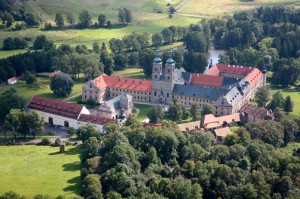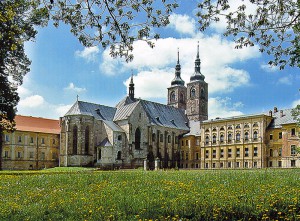Teplá Monastery
By Tracy A. Burns
Situated in western Bohemia near the famous spa town of Mariánské Lázně (Marienbad), Teplá Monastery enthralls with its Baroque frescoes and stunning library, the second oldest in the country. Yet the library is not the only space that will leave you breathless. The Annunciation of the Lord Church with its Hroznata Chapel and Chapter Hall are also sure to impress.
History
 Established in 1193 for the Premonstratensian Order by Czech nobleman Hroznata, Teplá is now owned by the Premonstratensian Order. Historical events took place here: Czech King Václav I attended the monastery’s first mass. Unlike many other monasteries in the country, this one was not destroyed by the Hussites during the 15th-century Hussite Wars. While the church has been preserved from the 12th century, the library is the newest building, constructed from 1902 to 1907.
Established in 1193 for the Premonstratensian Order by Czech nobleman Hroznata, Teplá is now owned by the Premonstratensian Order. Historical events took place here: Czech King Václav I attended the monastery’s first mass. Unlike many other monasteries in the country, this one was not destroyed by the Hussites during the 15th-century Hussite Wars. While the church has been preserved from the 12th century, the library is the newest building, constructed from 1902 to 1907.
The Library
One of the highlights of the tour is the library, which welcomes the visitor with an enormous illustrated Gothic manuscript and portraits of Empress Maria Theresa and her husband Francis Stephen of Lorraine. Now housing scientific collections, the space is vast: 24 meters long and 12 meters high. The library contains more than 100,000 books, including 700 manuscripts and 540 first printings. Forty percent of the books are written in Latin; others are in German and Czech. The oldest book dates from 915-930 AD, while perhaps the most well-known is the Codex Teplensis, the oldest translation of The New Testament into German from the 15th century. Most volumes, though, hail from the 18th and 19th centuries. The remarkable ceiling fresco depicts a celebration with monks and angels as well as four religious teachers and four Evangelists on the sides.
The Church
 The Annunciation of the Lord Church is the oldest part of the monastery, dating back to the end of the 12th and beginning of the 13th century, originally built in Romanesque-Gothic style, later redecorated with Baroque ornamentation. The Baroque reconstruction was carried out by master architect Kryštof Dientzenhofer in 1735. The church is 65.25 meters long and 15.6 meters high. Check out the intriguing large, wooden statues by Ignác Platzer – they depict saints and four religious teachers. The Baroque organ and the stained glass windows do not disappoint, either. Saint Augustine and Saint Ambrose are two of those represented in the four white with gold sculptures. Another statue in the room depicts King David. A large wooden slab and plaque on the floor demarcate the place where Hroznata was originally buried in 1217, in front of the Rococo main altar depicting Saint Norbert and Saint Václav in the center, accompanied by Saint Augustine, Saint Michal, and Saint Anna. The enormous 18th-century Baroque canvases on the sides of the main altar feature Moses and Jesus Christ being placed on the cross.
The Annunciation of the Lord Church is the oldest part of the monastery, dating back to the end of the 12th and beginning of the 13th century, originally built in Romanesque-Gothic style, later redecorated with Baroque ornamentation. The Baroque reconstruction was carried out by master architect Kryštof Dientzenhofer in 1735. The church is 65.25 meters long and 15.6 meters high. Check out the intriguing large, wooden statues by Ignác Platzer – they depict saints and four religious teachers. The Baroque organ and the stained glass windows do not disappoint, either. Saint Augustine and Saint Ambrose are two of those represented in the four white with gold sculptures. Another statue in the room depicts King David. A large wooden slab and plaque on the floor demarcate the place where Hroznata was originally buried in 1217, in front of the Rococo main altar depicting Saint Norbert and Saint Václav in the center, accompanied by Saint Augustine, Saint Michal, and Saint Anna. The enormous 18th-century Baroque canvases on the sides of the main altar feature Moses and Jesus Christ being placed on the cross.
The Hroznata Chapel
To one side of the main altar is the Hroznata Chapel, where the remains of Hroznata have been preserved in a white, marble altar. Take a look at the painting showing Hroznata as a knight founding two monasteries. Don’t overlook the altar of Saint Theodore with its finely carved wood and statue enclosed in glass. Another sculpture, this one white, depicts Hroznata dead, flanked by two statues denoting allegories. The amazing fresco above the chapel is divided into three sections: one depicts Hroznata being captured by robbing knights; another portrays the dead Hroznata in prison at Kinsberg Castle, and the third shows him ascending to Heaven.
Keep in mind that the church and chapel may not always be accessible for tours. If that is the case, the library, convent rooms, and museum gallery still make for a more than awe-inspiring experience.
The Convent Rooms
The Chapter Hall has astounding ceiling frescoes with rich stucco decoration. The frescoes show the 12 apostles with Saint Norbert. On one ceiling fresco, Saint Norbert’s coffin is being hauled to Prague’s Strahov Monastery in 1627. The Winter Refectory boasts a wall fresco of the Last Supper from 1816 while a ceiling fresco pays homage to Saint Paul. In the courtyard are four Baroque statues: Saint Prokop, Saint John of Nepomuk, Saint Václav, and Saint Vít.
With a breathtaking library, architecture going back to the 12th century, and spectacular Baroque frescoes, Teplá Monastery is sure not to disappoint and certainly ranks among the most intriguing monasteries in the country.




